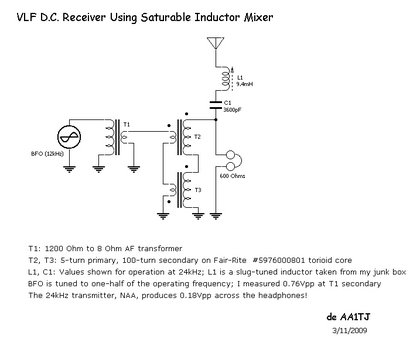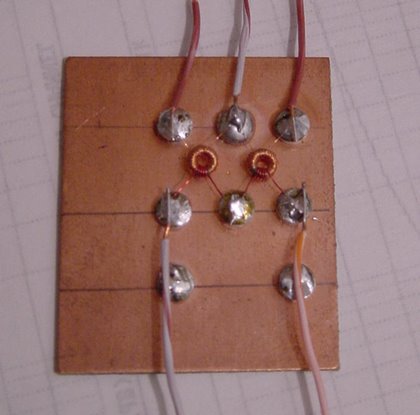(Please "click-on" the above image to enlarge)
The product detector in this "gain-less," direct-conversion receiver uses a pair of tiny, ferrite toroid cores. My bench audio frequency signal generator provides the beat frequency oscillator (BFO). The ferrite cores saturate on the peaks of the BFO waveform, resulting in a magnetic, commutating, subharmonic (Polyakov) mixer. This mixer directly drives a pair of magnetic headphones.
The project took less than an hour; from original conception to working receiver. I'd been playing with a saturable magnetic AM modulator on the bench, when it occurred to me that my modulator ought to work as a VLF product detector. With my audio frequency signal generator set at 12.4kHz, the FSK modulated signal from the U.S. Navy's station, NAA, was so loud that I could hear it from anywhere in my shack with the headphones resting on a workbench. Of course, NAA, puts out a tad more power than I'm used to hearing in my normal QRP activity! The 40m, end-fed wire that I used for my antenna amounts to a very short "whip" at these low frequencies.
Please click here to listen to a short audio file of NAA's signal taken from the output of this receiver.
The saturable cores that I used are Fair-Rite #5976000801. Each core measures 3.95mm O.D. x 2.15mm I.D. x 1.35mm. These high-permeability (Material 76), ferrite cores saturate at ~0.4 Tesla. The minimum BFO voltage vs the number of primary turns required for the onset of saturation may be approximated as:
E = (N x F)/181E^3
Where: N is the number of primary turns, F is the BFO frequency (Hz) and E is the applied BFO voltage (Vpp). For example, my 5-turn winding requires a minimum BFO level of 330mVpp at 12kHz in order to drive the core into saturation. I measure a BFO amplitude of 760mVpp across the primaries of T2 and T3.
The impedance looking into T2 and T3 from the BFO side, is quite low. T1 improves the impedance match between the BFO and the saturable cores.
Here's a photo of my saturatable mixer/modulator.

